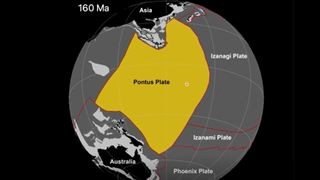Description

Disclaimer: Copyright infringement not intended.
Context
- Recent discovery of a long-lost tectonic plate, the 'Pontus plate,' which disappeared approximately 20 million years ago, was made by scientists studying ancient rocks in Borneo.
- Discovered by Suzanna van de Lagemaat, a doctoral candidate at Utrecht University in the Netherlands, and her colleagues.
Details
Introduction
- The Pontus Tectonic Plate is a minor tectonic plate located in the northern part of the Eastern Hemisphere.
- It is positioned in the northern and eastern regions of the Mediterranean Sea, covering parts of southern Europe and western Asia.
Boundaries
- Borders:
- North and west: Eurasian Plate.
- South: Anatolian Plate.
- Southeast: Arabian Plate.
- Eastern boundary: Indistinct, associated with the convergence zone between the Eurasian Plate and the Arabian Plate.

Characteristics of the Pontus Plate
- The Pontus plate was a significant tectonic plate, about a quarter of the size of the Pacific Ocean.
- It once underpinned the region now known as the South China Sea.
- Named the 'Pontus plate' due to its association with the ancient Pontus Ocean.
Plate's History and Fate
- The Pontus plate likely formed at least 160 million years ago, although its actual age could be older.
- Over time, it gradually diminished in size before being pushed under the Australian plate to the south and China to the north, ultimately disappearing 20 million years ago.
Geological Significance
- Contribution to geological evolution and tectonic activity of the broader region.
- Formation of geological features, including:
- Pontic Mountains in northern Turkey.
- Influence on the tectonic evolution of the broader Mediterranean region.
Seismic Activity
- Relatively low seismic activity compared to more active plates.
- Occasional seismic events, including earthquakes and volcanic activity.
- Requires continuous monitoring and study to understand the plate's behavior and implications for the surrounding regions.
About Tectonic Plates
- Tectonic plates are large, rigid pieces of the Earth's lithosphere that fit together like a jigsaw puzzle.
- These plates, along with the uppermost part of the mantle, constitute the Earth's outer shell, and their movement has given rise to many of the geological features we observe today.
Definition and Composition
- Tectonic plates are large, rigid pieces of the Earth's lithosphere, which is composed of the crust and uppermost mantle.
- They are typically composed of both continental and oceanic crust, and their thickness can vary from about 6 to 70 kilometers.
Types of Plates
- There are primarily seven major tectonic plates: the African Plate, Antarctic Plate, Eurasian Plate, North American Plate, South American Plate, Pacific Plate, and Indo-Australian Plate. Additionally, there are several minor plates and microplates.
Plate Boundaries
- Tectonic plate boundaries are the regions where these plates interact, leading to various geological phenomena. There are four main types of plate boundaries:
- Divergent boundaries, where plates move away from each other.
- Convergent boundaries, where plates move toward each other and collide.
- Transform boundaries, where plates slide horizontally past each other.
- Plate boundary zones, where multiple interactions occur, leading to complex geological processes.
Geological Phenomena
- Tectonic plate movements give rise to several geological phenomena, including:
- Earthquakes: Sudden release of energy along plate boundaries or faults.
- Volcanic activity: Eruptions at subduction zones and divergent boundaries.
- Mountain formation: Collision of plates leads to the uplift of mountain ranges.
- Rift valleys: Divergent boundaries create rifts and rift valleys.
Driving Mechanisms
- Plate tectonics is primarily driven by two mechanisms:
- Ridge push: The force generated by the elevated mid-ocean ridges that pushes plates apart.
- Slab pull: The gravitational force that pulls a subducting plate into the mantle.

Conclusion
This rediscovery of the Pontus plate provides valuable information about the Earth's tectonic history and helps to fill gaps in our understanding of the dynamics of ancient tectonic plates. Studying tectonic plates is fundamental to comprehending the dynamic processes that have shaped the Earth's surface and continue to influence its geological evolution.
|
PRACTICE QUESTION
Q. Discuss the significance of tectonic plates in shaping the Earth's surface and the implications of their movements on geological phenomena. (150 Words)
|











